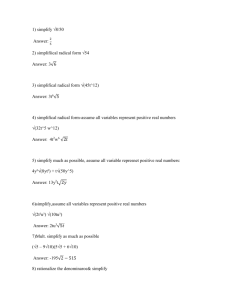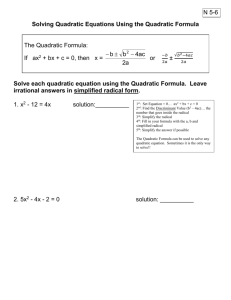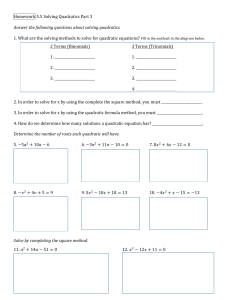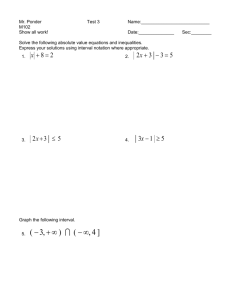Notes for Solving Quadratics by the Square Root Principle
advertisement
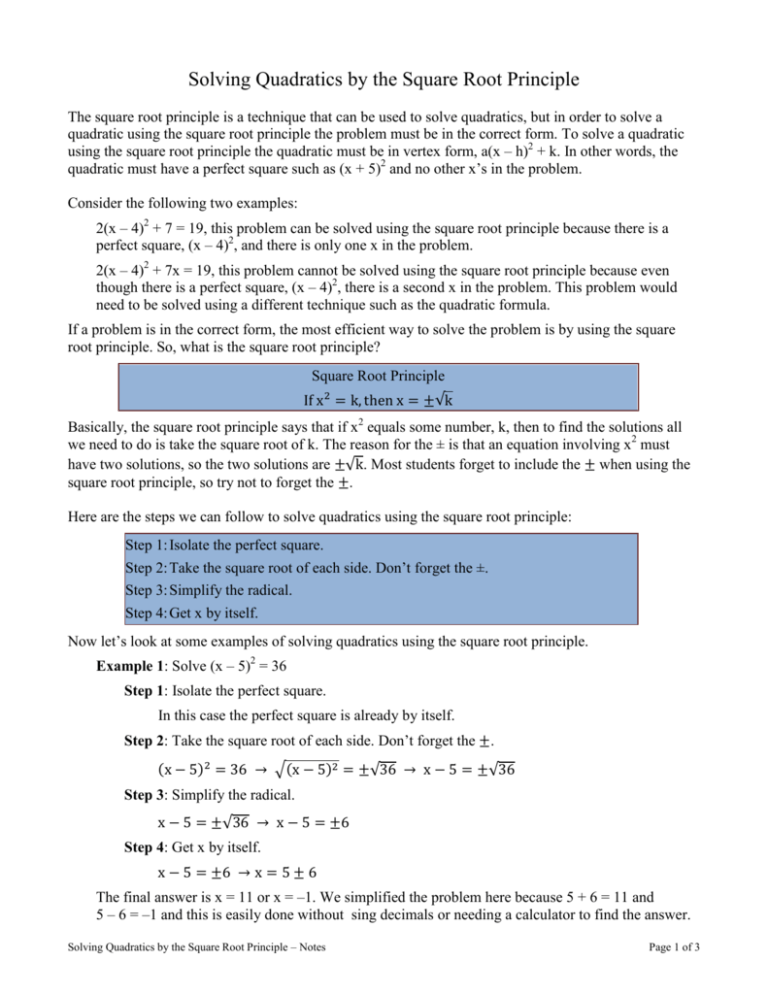
Solving Quadratics by the Square Root Principle The square root principle is a technique that can be used to solve quadratics, but in order to solve a quadratic using the square root principle the problem must be in the correct form. To solve a quadratic using the square root principle the quadratic must be in vertex form, a(x – h)2 + k. In other words, the quadratic must have a perfect square such as (x + 5)2 and no other x’s in the problem. Consider the following two examples: 2(x – 4)2 + 7 = 19, this problem can be solved using the square root principle because there is a perfect square, (x – 4)2, and there is only one x in the problem. 2(x – 4)2 + 7x = 19, this problem cannot be solved using the square root principle because even though there is a perfect square, (x – 4)2, there is a second x in the problem. This problem would need to be solved using a different technique such as the quadratic formula. If a problem is in the correct form, the most efficient way to solve the problem is by using the square root principle. So, what is the square root principle? Square Root Principle √ Basically, the square root principle says that if x2 equals some number, k, then to find the solutions all we need to do is take the square root of k. The reason for the ± is that an equation involving x2 must have two solutions, so the two solutions are √ . Most students forget to include the when using the square root principle, so try not to forget the . Here are the steps we can follow to solve quadratics using the square root principle: Step 1: Isolate the perfect square. Step 2: Take the square root of each side. Don’t forget the ±. Step 3: Simplify the radical. Step 4: Get x by itself. Now let’s look at some examples of solving quadratics using the square root principle. Example 1: Solve (x – 5)2 = 36 Step 1: Isolate the perfect square. In this case the perfect square is already by itself. Step 2: Take the square root of each side. Don’t forget the ( ) √( ) √ . √ Step 3: Simplify the radical. √ Step 4: Get x by itself. The final answer is x = 11 or x = –1. We simplified the problem here because 5 + 6 = 11 and 5 – 6 = –1 and this is easily done without sing decimals or needing a calculator to find the answer. Solving Quadratics by the Square Root Principle – Notes Page 1 of 3 Example 2: Solve 3(x + 7)2 – 2 = 22 Step 1: Isolate the perfect square. We need to isolate the perfect square by adding 2 and dividing by 3. ( ) ( ) Step 2: Take the square root of each side. Don’t forget the ( ) ) √( √ . √ Step 3: Simplify the radical. √ √ Step 4: Get x by itself. √ √ √ . The final answer is Example 3: Solve 2(x – 4)2 + 7 = –20 Step 1: Isolate the perfect square. We need to isolate the perfect square by subtracting 7 and dividing by 2. ( ) ( ) Step 2: Take the square root of each side. Don’t forget the ( ) √( √ √ ) . √ Step 3: Simplify the radical. The problem is written this way to remind us to rationalize the denominator. √ √ √ √ √ √ √ √ Step 4: Get x by itself. √ The final answer is- √ √ Solving Quadratics by the Square Root Principle – Notes √ Page 2 of 3 Example 4: Solve 3(x + 9)2 – 11 = 41 Step 1: Isolate the perfect square. We need to isolate the perfect square by adding 11 and dividing by 3. ( ) ( ) Step 2: Take the square root of each side. Don’t forget the ( ) √ √ ) √( . √ Step 3: Simplify the radical. The problem is written this way to remind us to rationalize the denominator. √ √ √ √ √ √ √ √ Step 4: Get x by itself. √ √ √ The final answer is- Example 5: Solve 4(x – 6)2 – 35 = 14 Step 1: Isolate the perfect square. We need to isolate the perfect square by adding 35 and dividing by 4. ( ) ( ) Step 2: Take the square root of each side. Don’t forget the ( ) √( ) √ . √ √ Step 3: Simplify the radical. √ √ Step 4: Get x by itself. The final answer is- Solving Quadratics by the Square Root Principle – Notes Page 3 of 3

